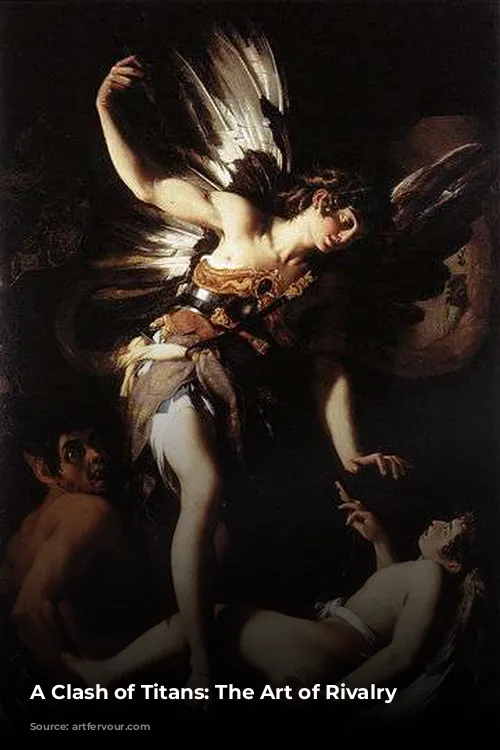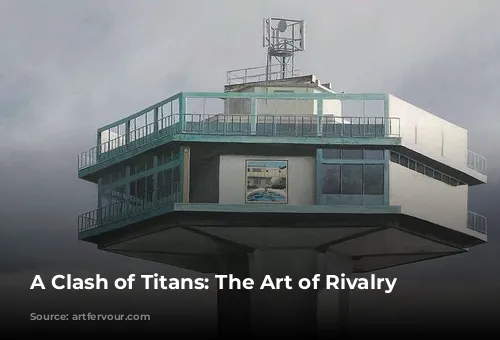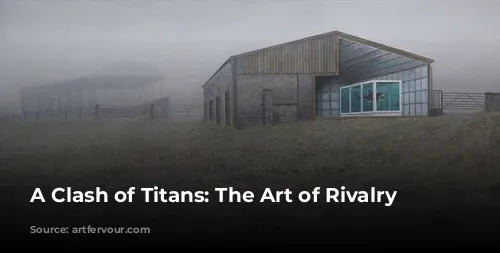The world of art is not just about beautiful creations; it’s also about the passionate people behind them. From the Renaissance masters to modern-day street artists, rivalries have fueled artistic innovation and given us some of the most compelling stories in art history. We’ll explore these dramatic clashes, from the silent battles of Michelangelo and da Vinci to the fiery feuds of Turner and Constable.

The Unfinished Masterpieces
Michelangelo and Leonardo da Vinci, two of the most celebrated artists of the Renaissance, shared a common thread: unfinished masterpieces. Michelangelo’s “Battle of Cascina,” a monumental fresco depicting a Florentine victory, was left incomplete when the artist was summoned to Rome. Similarly, Leonardo’s “Battle of Anghiari,” a fresco that aimed to showcase his mastery of oil paint, met a disastrous end when the heat from braziers melted the paint.
But the story doesn’t end there. The two artists, despite working on separate projects, were engaged in a silent rivalry within the same building. Commissioned to decorate the Hall of the Five Hundred in Florence, their works were destined to face each other on opposing walls. It’s as if they were locked in a silent battle, their brushes speaking volumes even without a word.

A War of Words and Art
The rivalry between Michelangelo and da Vinci wasn’t just confined to their art. Their personal relationship was marked by bitterness and mutual disrespect. Michelangelo famously ridiculed da Vinci for his unfinished horse statue in Milan, while da Vinci suggested castrating Michelangelo’s “David,” a symbol of Florentine pride. Their rivalry was a reflection of the fierce competition that existed during the Italian Renaissance, where artistic brilliance often came at the cost of personal animosity.
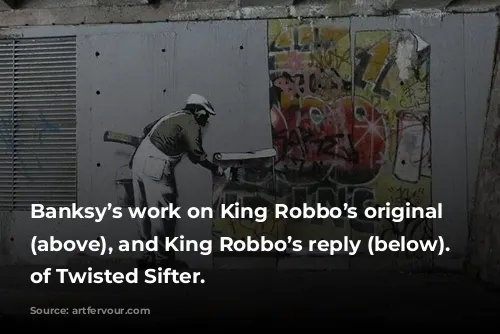
The Ghosts of Artists Past
The tension between artists isn’t a new phenomenon. Andrew McIntosh’s exhibition, “You Were Shit in the 80s,” explores this theme by showcasing famous artworks in a post-apocalyptic setting. These paintings, representing famous rivalries like those of Lucian Freud and Francis Bacon, and David Hockney and Damien Hirst, stand as haunting reminders of the everlasting battle for artistic supremacy.
The artist’s choice to depict these works in derelict, abandoned structures highlights the fragility and resilience of art. It shows that art survives through generations of conflict and change, a testament to its enduring power.

A Street War of Stencils and Graffiti
Banksy and King Robbo, two renowned street artists, engaged in a high-stakes game of graffiti warfare on the streets of London. Their rivalry began when Banksy defaced a Robbo piece, prompting a series of retaliatory strikes. Robbo, the self-proclaimed “King of Graffiti,” wouldn’t be outdone, and the two artists engaged in a public display of artistic dominance.
Their struggle was more than just a battle for street cred. It highlighted the power of graffiti as a form of artistic expression, a way to reclaim urban spaces and create a world of creativity in the midst of mechanical life.
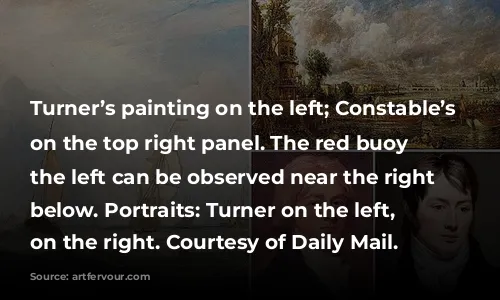
From Ink to Insults: A Poet’s Revenge
Caravaggio, a master of Baroque art, wasn’t just known for his paintings; he was also a talented poet, and he used his words to lash out at his rival, Giovanni. The two artists were vying for the same coveted church commission, and after Giovanni painted a derivative work of Caravaggio’s “Amor Vincit Omnia,” Caravaggio penned a series of crude poems, comparing Giovanni’s work to toilet paper.
This led to a legal battle, with Giovanni suing Caravaggio for libel. The intensity of their rivalry was a testament to the power and passion that fueled the artistic world of the early 17th century.
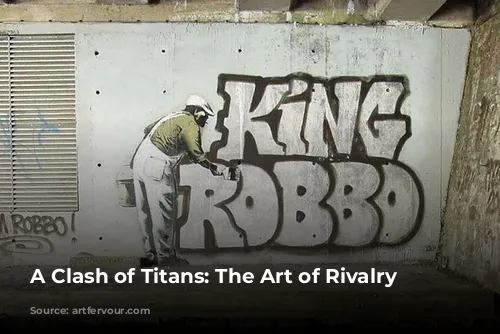
A Clash of Styles: Turner vs. Constable
The rivalry between JMW Turner and John Constable, two leading landscape painters, was a battle of artistic ideologies. Turner, known for his dramatic use of light and color, embraced the Romantic movement, while Constable, a champion of realism, focused on capturing the beauty of the English countryside.
Their feud escalated when Turner, seemingly jealous of Constable’s success, painted a red buoy in his own seascape, deliberately overshadowing Constable’s “The Opening of Waterloo Bridge.” This act of artistic sabotage solidified Turner’s reputation as a genius while simultaneously undermining Constable’s work. The story illustrates the intense competition and professional jealousy that existed even among the most celebrated artists.

A Cup of Coffee and a Fury
The rivalry between Jean-Auguste-Dominique Ingres and Eugene Delacroix wasn’t simply about art; it was about a clash of artistic values. Ingres, a staunch neoclassicist, prized precision and form, while Delacroix, a Romantic artist, embraced emotion and vibrant color.
Their disdain for each other’s work reached a boiling point at a party when Ingres, enraged by Delacroix’s presence, spilled a cup of coffee over the other artist, shouting about the value of “drawing” and “honesty.” Their public feud became a reflection of the larger debate between traditional and modern art, highlighting the deep divisions that existed within the art world during the 19th century.
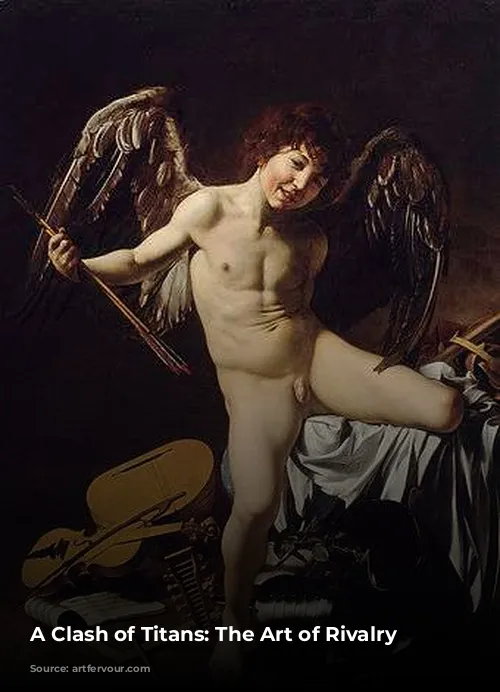
A Battle of Ideologies: Greenberg vs. Rosenberg
The rivalry between Clement Greenberg and Harold Rosenberg, two influential art critics, was a battle of artistic ideologies. Greenberg, a proponent of formalist criticism, believed that art should be judged solely on its form and composition, while Rosenberg, a champion of Abstract Expressionism, emphasized the artist’s creative process and emotional expression.
Their feud manifested in public attacks and heated debates over the work of artists like Jackson Pollock and Willem de Kooning. They were essentially locked in a war of words, each striving to establish their own vision of what constituted “true art.” Their rivalry ultimately contributed to the development of American Abstract Expressionism, a movement that continues to influence art today.
Beyond the Bitter Rivalry
Although these rivalries were often marked by bitterness and animosity, they also played a crucial role in shaping the art world. They pushed boundaries, fueled innovation, and ultimately led to the creation of some of the most iconic works of art.
Whether it’s the silent battle of Michelangelo and da Vinci, the street wars of Banksy and Robbo, or the passionate debates of Greenberg and Rosenberg, these rivalries demonstrate the complex and dynamic nature of art history. Beyond the personal conflicts, there lies a deeper truth – rivalry itself is a form of art.
So, the next time you encounter a work of art, take a moment to consider the story behind it. You might be surprised to find that a bitter rivalry is often the catalyst for something truly extraordinary.



